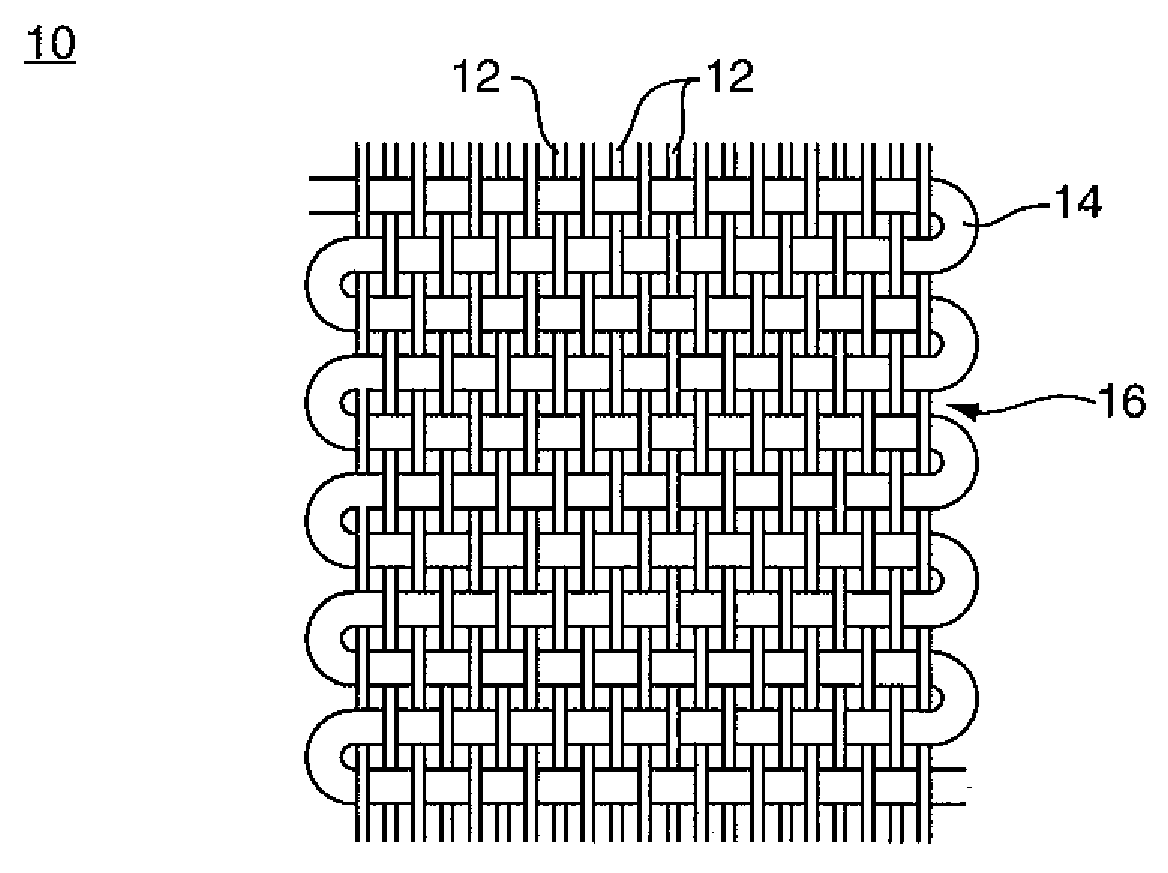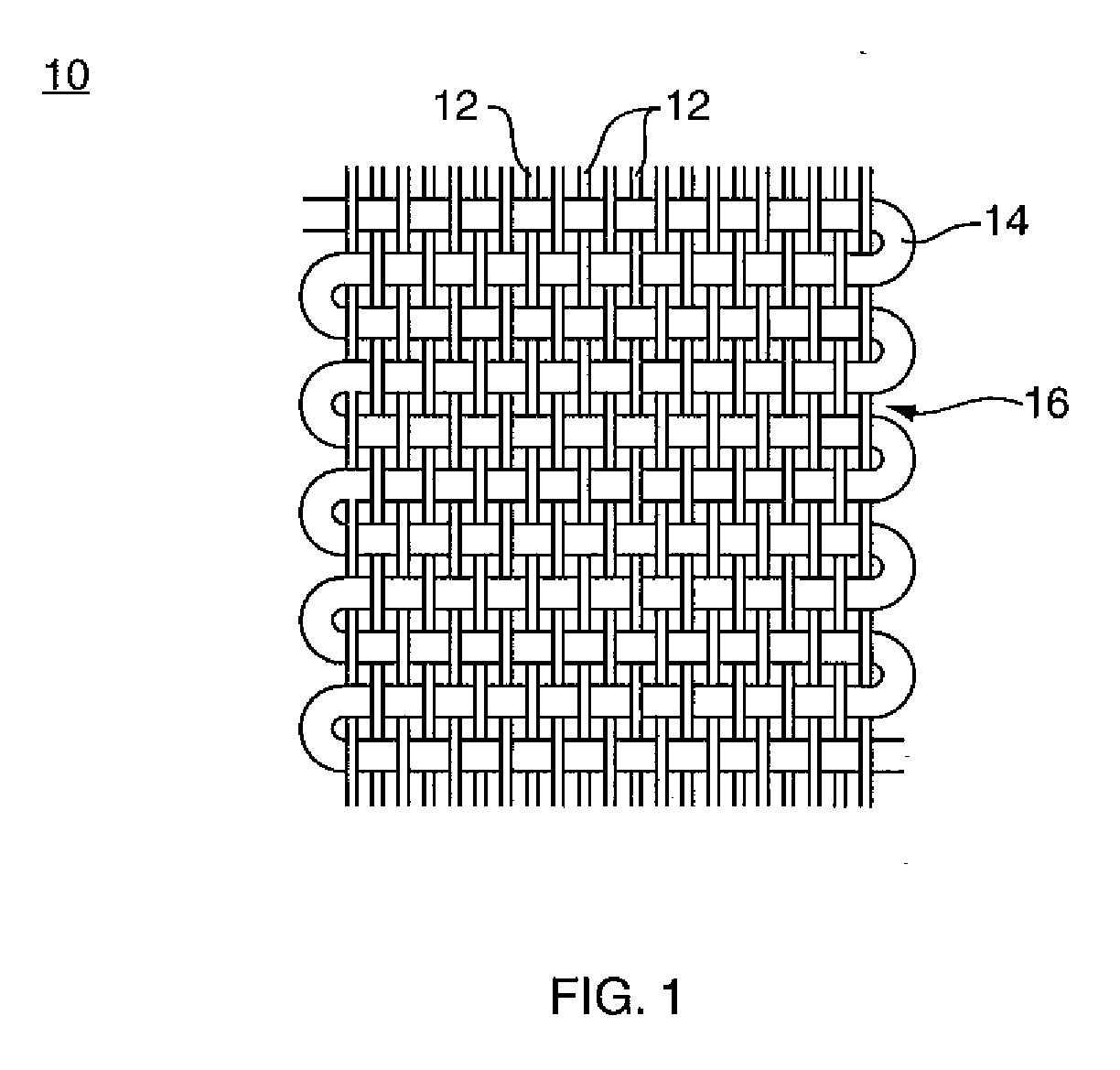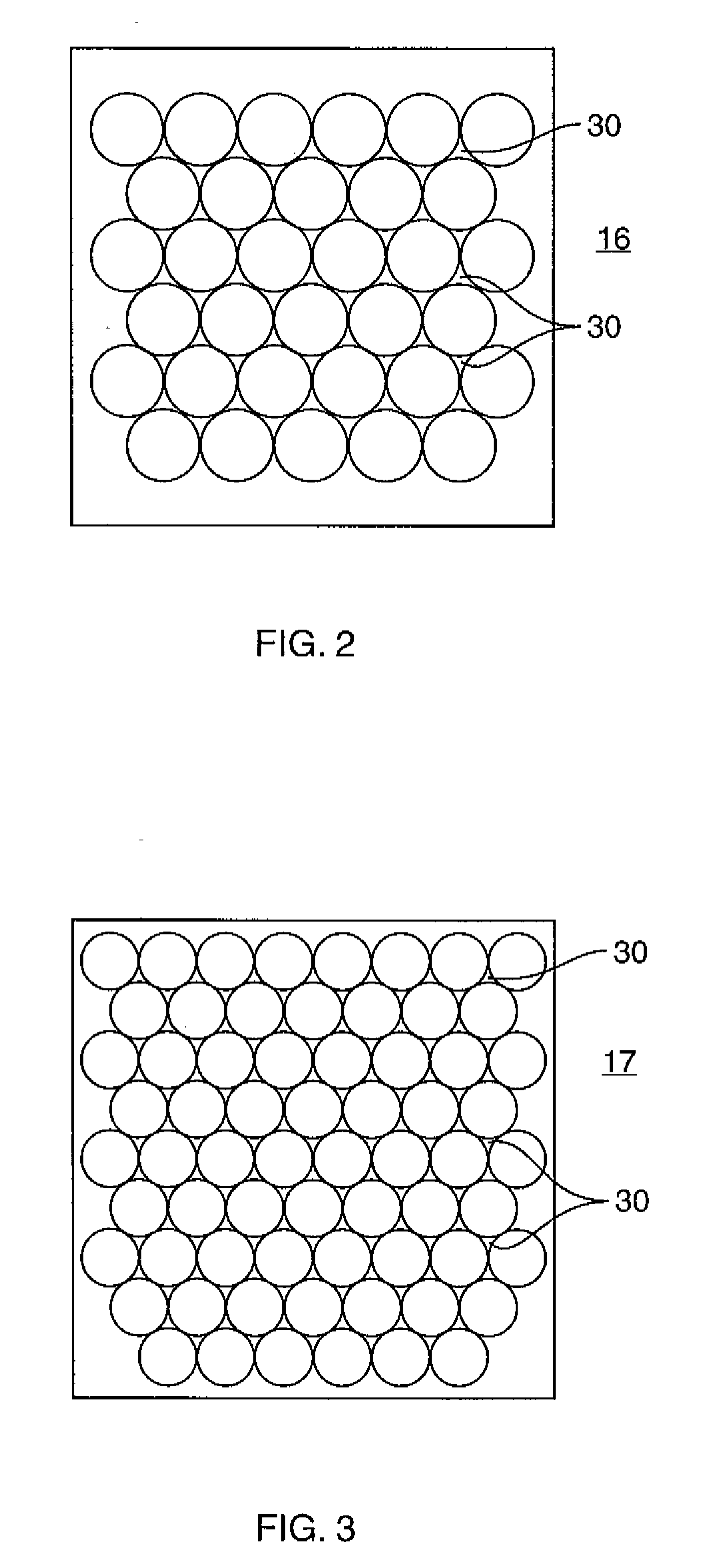[0010]It is an object of the present invention to provide a convenient, easy-to-use, flexible fabric that remains cool for an extended period of time when contacted against an object to be cooled, such as a person's skin or an inanimate object for which temperature maintenance is desirable, and a method of making the fabric. It is also an object of the present invention to provide a
moisture management fabric that can assist in maintaining a sustained thermal condition of an object for an extended period of time with minimal effort and no temperature-regulating chemicals in the fabric. Further, it is an object of the present invention to provide a method of manufacturing such a fabric with such characteristics.
[0014]Present manufacturing processes that include a peaching step perform the peaching on the front side only, or at least do so first, thereby minimizing the ability to pull fibers on the front side toward the back side of the fabric. Instead, the peaching on the front side is done to create texture,
pile and / or “hand” on the front side of the fabric, such as to enhance the insulative characteristics of the fabric with little or no regard for the condition of the back side or establishing a cooling functionality.
[0015]The peaching step of the manufacturing method of the present invention involves peaching both the front and back sides of the fabric multiple times each to create a homogeneous blend of the different materials. That is, at least portions of the
fiber material of the front side and the
fiber material of the back side become entangled with one another. These homogeneous blends of materials having dissimilar characteristics maintain an
atmosphere that is conducive to maximizing the uniqueness of the individual
fiber properties and thus control / regulate the rate of evaporation.
[0016]The fabric of the present invention is configured to facilitate liquid removal from the surface of the object, store liquid therein, and slow the evaporation of liquid away from the fabric to the
atmosphere. Any type of prior commercially available fabric designed to cool is limited to causing rapid transport of liquid away from the skin and equally rapid transport of that liquid completely out of the fabric. In other words, prior cooling fabrics using no chemicals to induce cooling artificially, are configured to get liquid away from the skin as soon as possible and nothing more. This may achieve short term cooling, but fails to enable longer term cooling, particularly for individuals who are not exercising (and thereby generating their own
moisture to produce evaporative cooling). The fabric of the present invention utilizes the
cooling effect available from retained liquid. By withdrawing that liquid, at what is likely to be its highest temperature at the surface of the object, from the surface, storing the liquid within the fabric so that it cools down to become a more effective evaporative agent than it was when at a higher temperature, and restricting the ability of that cooled liquid to quickly evaporate from the
atmosphere-side of the fabric, ensures a substantially longer cooling capability than has been made available.
[0017]The present invention is directed to creating in a fabric a controlled environment that maximizes wicking where desired and retention of liquid molecules within the
fabric structure. The invention utilizes yarns / fibers organized in the manner described herein to maximize fabric traits that interfere with the normal process of evaporation away from the fabric. These traits include diverting liquid from the surfaces of individual fibers near the object to the interior of the fabric,
trapping the liquid at the interior, and, ultimately, slowing the rate of evaporation from the fabric. As used herein, “evaporation” means the change of a liquid into a vapor at a temperature below the
boiling point of that liquid; a condition that exists at the surface of the liquid, where molecules with the highest
kinetic energy are able to escape, when this happens, the average
kinetic energy of the liquid is lowered, and its temperature decreases. With that in mind, the present invention is configured to facilitate evaporation within the fabric as much as possible to aid in the cooling of the object while also slowing evaporation of liquid from the fabric itself.
Fiber characteristics, density and arrangement all have a hand in regulating
evaporation rate. The present invention involves fiber selection, positioning and physical modification to achieved desired evaporation control. For example, the intermediary portion of the fabric includes a network of interstices or capillaries the configuration of which is defined by the fiber shape and the arrangement of fibers with respect to one another. That network slows the progression of liquid completely out of the fabric and allows for evaporative cooling of the liquid that facilitates
heat transfer from the object to be cooled.
[0019]The cooling properties of the fabric of the present invention, which may include maintaining an object at a selected temperature for a period of time, makes it amenable to being used in a large variety of applications. For example, the fabric may be used to wholly or partially form a plurality of apparel and personal products that can be worn or otherwise used by a person in the hot sun or while exercising to keep cool. As another example, the fabric may be used to wholly or partially form a plurality of skin-associated
medical health products that can be used to keep a patient cool. The fabric of the present invention satisfies this need because it becomes cool at its interface with the patient's skin by wicking away any “warm” liquid (e.g.,
perspiration), storing that liquid in the intermediary portion such that it begins to cool by slowing its progression through to the other surface of the fabric and enabling the retained relatively cooler liquid to provide further cooling of the skin. The fabric may also be used to keep inanimate objects cooled, such as materials to be transported, for example. The fabric created through the combination of materials and manufacturing steps described provides maximum wicking and absorption where needed near the object, and
moisture storage characteristics that allow for evaporative cooling within the fabric and reducing the rate of normal liquid evaporation away from the fabric.
 Login to View More
Login to View More 


